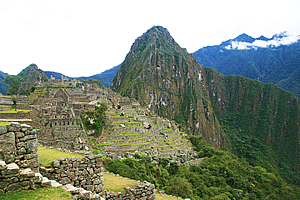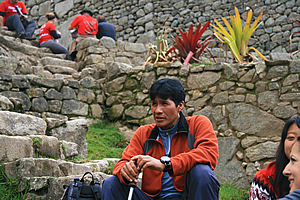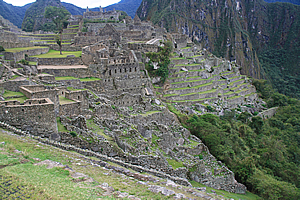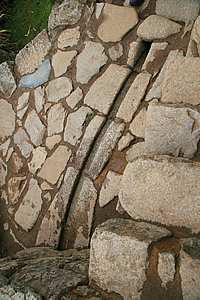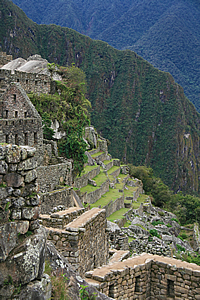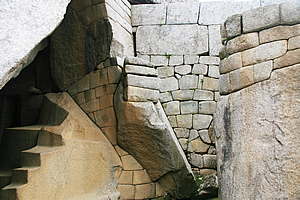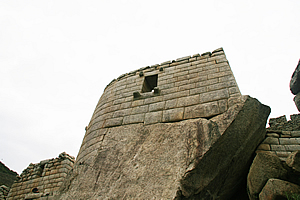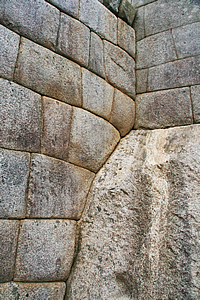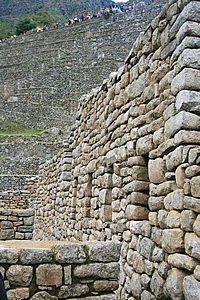--- Archive files ---
Home > Treks > Inca Trail > Day 6 > 6.4 |
Tour around the City
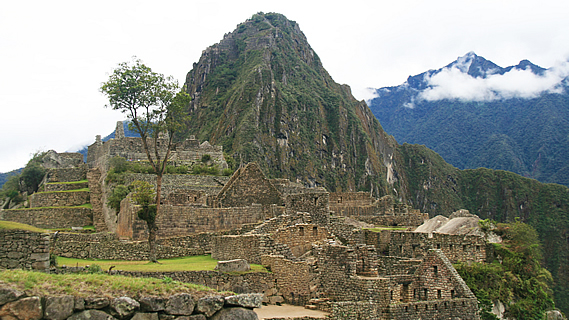
WILBUR led us along a grassy terrace across the rows of huge stone retaining walls down the slope of the hill. The terrace was very flat, and I’m sure they would have worked out what species of vegetable grew best in each part of the terrace that we walked upon. Studies have shown though that the areas reserved for horticulture were not sufficient to have supported the population there.
Machu Picchu from near the entrance |
We reached the end of the terrace near the bottom of the east agricultural sector and climbed down to another level where we all sat down to listen to Wilbur explain the history of the city of Machu Picchu. We crossed our fingers hoping he wouldn’t do his rain dance, and thankfully it didn’t rain. Just above him was a short row of large bromeliads, the only ones in the entire city. From here there was a great view across the Group of the Three Doorways.
The ruins along the top of the ridge were intact and well maintained, but I noticed the further down the slope I looked, the more derelict the rubble was. Towards the bottom the terrace walls were no more than jumbled piles of rock interspersed amongst the bright green grass at the edge of the forest further below. Some of the rubble had planks of wood across them to assist any archaeologists exploring the area. It was as if the rubble was supposed to merge into the chaos of the forest below.
Wilbur talks about the city |
The city had been established as a religious retreat for the wealthy Incan emperor. It had taken fifty years to build. A hundred years later in 1572 the city was abandoned. Although the Spanish had never discovered it during their conquest, it is believed most of the inhabitants died from smallpox introduced by the invaders and carried by people who still travelled here. It remained hidden from the Spanish despite being just eighty kilometres from the capital city Cusco.
Ruins of Machu Picchu |
It lay in ruins with the forest gradually taking over it like the forests had overtaken the temples in Cambodia. Finally in 1916 it was rediscovered, and after many years of preservation effort, it had largely been restored for us and many other tourists to enjoy now.
The city was divided into two main areas, there was the commercial and religious area where we were exploring. Further below in the other section close to the monolithic mountain of Waynapicchu was the residential area.
Fountain |
Ruins of Machu Picchu |
The movement of the big stones was a mystery. The wheel wasn’t used in their culture apart from on children’s toys. The lack of strong beasts of burden coupled with the steep terrain would have rendered the wheel impractical.
The city contains at least one hundred structures and a hundred flights of stairs and many fountains. The stairs, fountains and the foundations of many of these buildings were carved directly into the solid granite.
Wilbur successfully completed his presentation without any rain falling. I noticed though the clouds were starting to descend. The higher peaks that had been visible earlier this morning were now enshrouded with tufts of cloud.
Perfect complex construction |
We climbed up to the temple area of the city. The temples were built from the most perfectly shaped stones. There were some huge boulders there that formed part of the natural landscape. All the surrounding stones were perfectly cut to fit around the boulders. There were a few interesting blocks of stone on the terrace. I didn’t know what they were for. Perhaps they were for irrigation, or maybe they were construction blocks that had been dislodged and the archaeologists couldn’t put them back together again.
We followed a stone stairway between the stone walls directly uphill towards a round temple known as the Temple of the Sun. On the way up, I passed a small water channel carved perfectly in the rock. It was still carrying a large trickle of water perfectly along the channel as if it were built just yesterday – not five hundred years ago. There were a couple of other water supply channels with a flow of about a litre every two minutes. The irrigation system comes from a single spring considered to have a very strong spiritual significance. This one spring was designed to provide water to every house and building in the city.
Temple of the Sun |
The Temple of the Sun was built on a large strangely shaped boulder. The boulder was larger on top than at the bottom creating an overhanging ledge which the temple stood atop. Underneath the tower was the Royal Tomb which was roped off. There were strange staircase shaped rocks giving it quite an abstractly geometrical look. These rocks formed the symbol of the Pachamama. Inside the tomb were the mummies of the Inca’s ancestors and high imperial dignitaries. The Inca would enter to worship them and offer tributes.
We climbed a stone stairway and entered the temple of the sun. From inside the temple we could see through a trapezoidal window up to the Sungate. The window was positioned exactly to view the sun rising in between the two pillars of the Sungate on exactly the spring and autumn equinoxes. From the temple the priests were also able to work out the summer and winter solstices, and also when the midday sun passed vertically overhead as we were in the tropics. It was all very cleverly done especially with the Sungate being a couple of kilometres away. Their sense of astronomy was amazing like many other primitive cultures who built temples.
Perfect stonework |
Perfect stonework |
In the middle of the temple, the rock had been cut flat apart from a stone altar carved into the same rock that held the temple. No doubt this was used for religious purposes.
There was something very religious about this place. The people who had built this city, and who had briefly lived there must have been very spiritual and in close fellowship with nature characteristic of adherents to the animistic religions.
Next to the Temple of the Sun was the Palace of the Princess, believed to have been used as a special retreat for virgins to be sacrificed to the sun, or who would have otherwise taken part in religious rituals.
<< Previous | Next >> |
|
||
About this Page
|
||
|
|
|
Where is Walkabout Jeff? |
|
|
|
|
What is happening in Walkabout Jeff's hometown?
|
|
|
|
|
Who is Walkabout Jeff?Any normal person's idea of going out involves going to the local pub for a drink with a few mates. Walkabout Jeff isn't normal.
|
|
|
|
|
